List of shahanshahs of the Sasanian Empire
| Shahanshah of Ērānshahr | |
|---|---|
|
| |
| Details | |
| First monarch | Ardashir I |
| Last monarch | Yazdegerd III |
| Formation | 28 April 224 AD |
| Abolition | 651 |
| Residence |
|
The Shahanshahs of the Sasanian Empire or "the King of Kings of the Sasanian Empire" ruled over a vast majority of land. At its height, the empire spanned from Turkey in the west to Pakistan in the east, and also included territory in contemporary Caucasus, Yemen, UAE, Oman, Egypt, Israel, Lebanon, Jordan and Central Asia.
The Sasanian Empire was recognized as one of the main powers in the world alongside its neighboring arch rival, the Roman-Byzantine Empire, for a period of more than 400 years.[1][2][3][4] The Sasanian dynasty began with Ardashir I in 224, who was a Persian from Estakhr, and was descended from the Achaemenid Kings, and ended with Yazdegerd III in 651. The downfall of the Sasanian Empire proved of great significance and effects to Zoroastrianism, the state religion of the Sasanian Empire. The previous Zoroastrian shahanshahs were replaced with Muslim Caliphs who forced the Zoroastrians and their faith to endure harsh conditions, including the destruction of fire temples throughout the previous Sasanian Empire and marginalization of the faith.[5]
Sasanian state organization

In the Sasanian era, the term "the king of kings of Iran" (Middle Persian: šāhān šāh Ērān; En. Shahanshahs, New Persian: شاهنشاه ایران) is the Persian term for "King of Kings." was used from the time of its establishment by Ardashir. The term "king of kings of Iran" appears in Sasanian documents. In Kabe Zartosht inscription of Shapur I the Great the titles are chosen in a precise manner. In that Shapur names four of his Sasanian predecessors with different titles and in "an ascending order of importance" by giving the title (Xwaday) "the lord" to Sasan, "the king" to Papag, "the King of kings of Iran" to Ardashir, and "king of kings of Iran and non-Iran" to himself.[6]
Throughout its existence, the Sassanid Empire was an absolute monarchy. The Shahenshah was the height of authority, with satraps ruling over their satrapies underneath them. The shahanshah was the highest form of authority throughout the empire, but often faced rebellions from their satraps. In fact, the Sasanian Empire had been founded when a satrap rebelled against the Parthian Empire.[7]
The Sasanian Empire reached its greatest extent under Khosrau II, who reigned for 38 years; the longest reigning king was Shapur II, who reigned for 70 years.
The Sasanian kings regarded themselves as successors of the Achaemenid Empire, and many Sasanian kings' goal was to conquer all territory previously held by the Achaemenids.
List of shahanshahs
The table below lists Sasanian shahanshahs and titles used by them.
Titles used by the Sasanian shahanshahs was:
| # | Shahanshah | Coin or statue | Reigned from | Reigned until | Relationship to Predecessor | Notes | |||
|---|---|---|---|---|---|---|---|---|---|
| House of Sasan | |||||||||
| 1 | Ardashir I |  |
224 | February 242 | — |
| |||
| 2 | Shapur I |  |
12 April 240 | May 270 | Son |
| |||
| 3 | Hormizd I |  |
May 270 | June 271 | Son |
| |||
| 4 | Bahram I |  |
June 271 | September 274 | Brother |
| |||
| 5 | Bahram II |  |
274 | 293 | Son |
| |||
| 6 | Bahram III | 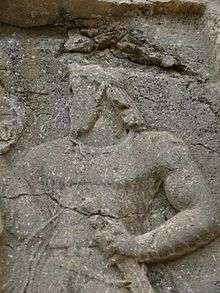 |
293 | 293 | Son |
| |||
| 7 | Narseh | 293 | 302 | Grand-uncle |
| ||||
| 8 | Hormizd II |  |
302 | 309 | Son |
| |||
| 9 | Adhur Narseh |  |
309 | 309 | Son |
| |||
| 10 | Shapur II | 309 | 379 | Brother |
| ||||
| 11 | Ardashir II |  |
379 | 383 | Brother |
| |||
| 12 | Shapur III | 383 | 388 | Brother | |||||
| 13 | Bahram IV | 388 | 399 | Son | |||||
| 14 | Yazdegerd I | 399 | 420 | Son | |||||
| 15 | Shapur IV |  |
420 | 420 | Son | ||||
| 16 | Khosrau |  |
420 | 420 | Cousin | ||||
| 17 | Bahram V | 420 | 438 | Cousin | |||||
| 18 | Yazdegerd II | 438 | 457 | Son | |||||
| 19 | Hormizd III |  |
457 | 459 | Son | ||||
| 20 | Peroz I | 457 | 484 | Brother | |||||
| 21 | Balash | 484 | 488 | Brother |
| ||||
| 22 | Kavadh I |  |
488 | 496 | Nephew |
| |||
| 23 | Djamasp | 496 | 498 | Brother | |||||
| 24 | Kavadh I |  |
498 | 531 | Brother |
| |||
| 25 | Khosrau I |  |
531 | 579 | Son | ||||
| 26 | Hormizd IV | 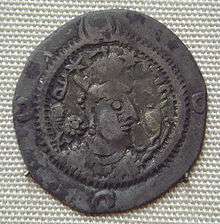 |
579 | 590 | Son | ||||
| 27 | Khosrau II |  |
590 | 590 | Son |
| |||
| House of Mihran | |||||||||
| 28 | Bahrām Chobin |  |
590 | 591 | Rebel |
| |||
| House of Sasan | |||||||||
| 29 | Khosrau II |  |
591 | 628 | Son of Hormizd IV |
| |||
| House of Ispahbudhan | |||||||||
| 30 | Vistahm |  |
591 | 595 | Uncle |
| |||
| House of Sasan | |||||||||
| 31 | Kavadh II |  |
628 | 628 | Son |
| |||
| 32 | Ardashir III |  |
628 | 629 | Son | ||||
| House of Mihran | |||||||||
| 33 | Shahrbaraz | 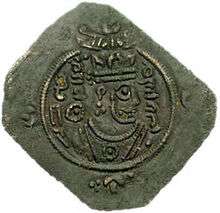 |
27 April 629 | 17 June 629 | General |
| |||
| House of Sasan | |||||||||
| 34 | Khosrau III |  |
629 | 629 | Nephew of Khosrau II | Briefly ruled in Khorasan as rival king | |||
| 35 | Borandukht |  |
17 June 629 | 16 June 630 | Daughter of Khosrau II |
| |||
| 36 | Shapur-i Shahrvaraz |  |
630 | 630 | Son of Shahrbaraz and a sister of Khosrau II | ||||
| 37 | Peroz II |  |
630 | 630 | Descended from Khosrau I | ||||
| 38 | Azarmidokht | 630 | 631 | Daughter of Khosrau II |
| ||||
| House of Ispahbudhan | |||||||||
| 39 | Farrukh Hormizd |  |
630 | 631 | General | ||||
| House of Sasan | |||||||||
| 40 | Hormizd VI | 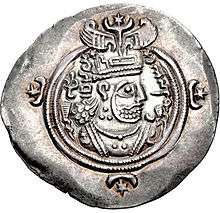 |
630 | 631 | Usurper | ||||
| 41 | Khosrau IV |  |
631 | 631 | Son of Khosrau II | ||||
| 42 | Farrukhzad Khosrau V | March 631 | April 631 | Son of Khosrau II | |||||
| 43 | Borandukht |  |
631 | 632 | Daughter of Khosrau II |
| |||
| 44 | Yazdegerd III | 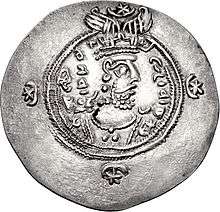 |
632 | 651 | Grandson of Khosrau II |
| |||
| Destruction of the Sassanid Empire | |||||||||
| - | Peroz III |  |
651 (In exile) | 679 (In exile) | Son |
| |||
| - | Narsieh |  |
679 (In exile) | Unknown | Son |
| |||
See also
Notes
- ↑ "The Cambridge Illustrated History of the Islamic World" (PDF). Retrieved 6 June 2014.
- ↑ (Shapur Shahbazi 2005)
- ↑ Norman A. Stillman The Jews of Arab Lands pp 22 Jewish Publication Society, 1979 ISBN 0827611552
- ↑ International Congress of Byzantine Studies Proceedings of the 21st International Congress of Byzantine Studies, London, 21–26 August 2006, Volumes 1-3 pp 29. Ashgate Pub Co, 30 sep. 2006 ISBN 075465740X
- ↑ Molavi 2002, p. 52.
- ↑ Frye, R. N. (1983), "The political history of Iran under the Sasanians", The Cambridge History of Iran, Cambridge University Press, 3 (1), ISBN 978-0-521-20092-9
|chapter=ignored (help), page 116. - ↑ Freedman 2000, p. 458.
References
- Molavi, Afshin (2002), Persian pilgrimages: journeys across Iran (Illustrated ed.), W. W. Norton & Company, ISBN 0-393-05119-6, retrieved 17 January 2010
- Freedman, David Noel (2000), Michael J. McClymond, ed., The Rivers of Paradise: Moses, Buddha, Confucius, Jesus, and Muhammad As Religious Founders, Wm. B. Eerdmans Publishing, ISBN 0-8028-2957-0
- Shapur Shahbazi, A. (2005), "Sasanian Dynasty", Encyclopedia Iranica, Columbia University Press, 1
